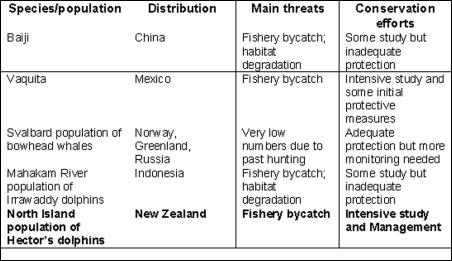Greater protection of NZ dolphins called for
International report calls for greater protection of New Zealand dolphins.
A new international report on endangered whales and dolphins has called for greater protection of New Zealand’s Hectors dolphin and warns other dolphin and whale species may be extinct within 10 years.
Forest and Bird Senior Researcher, Barry Weeber, said the report highlighted the threatened state of Hector’s dolphin, in particular the critically endangered North Island sub-species.
The report was prepared by the Cetacean Specialist Group of the World Conservation Union (IUCN), an intergovernmental and non-governmental conservation organization.
Mr Weeber said the report shows the perilous state of many populations of whales and dolphins. “Survey’s have found fewer than 25 of the world’s rarest dolphin, the baiji freshwater dolphin from China and that less than 100 North Island Hector’s dolphin may exist.”
“The report recommended increased protection of New Zealand’s endangered Hectors dolphin and the critically endangered North Island Hector’s dolphin.”
Mr Weeber said among the recommendations was an increase in the size of existing protected areas for Hectors dolphin to include the harbours and bays in the North Island marine mammal sanctuary, and also extend the offshore boundaries for North and South Island sanctuaries.
“The IUCN report follows another report in the journal Nature that revealed a crisis in world fisheries with plummeting fish numbers caused by over-fishing.”
Mr Weeber said fishing was highlighted as one of the major threat to dolphins of entanglement with fishing gear and the “appropriation of bays for aquaculture”.
“Forest and Bird will be asking the Government about the actions it intends to take to further protect Hectors dolphin in light of the IUCN’s recommendations,” Mr Weeber said.
“There is a crisis in the world’s marine environment that can no longer be ignored,” he said.
“Many New Zealanders are unaware of the seriousness of the situation in our marine environment. Fish stocks are declining, rare species are declining and heading towards extinction. The fishing industry is in denial and the government appears unable to stem the decline”, he said.
Note:
The Conservation Recommendation from Hector’s dolphin from the report the IUCN Cetaceans Specialist Group are:
Conservation recommendations: The Cetacean Specialist Group urges management authorities to implement the following, with the goals of reducing gillnet entanglement and other sources of human-caused mortality to sustainable levels throughout the species’ range, and eliminating human-caused mortality for the North Island population so that it can recover rapidly to a viable level: In areas with seriously threatened populations (e.g., North Island west coast) allow fishing only with methods known not to catch Hector’s dolphins (e.g., replace gillnetting or trawling with line fishing) and work toward reducing pollution, boat strikes, and other known and potential threats. Increase the size of existing protected areas. In particular, include the harbors and bays in the North Island sanctuary and extend the offshore boundaries of both sanctuaries. Implement a statistically robust observer program throughout the species’ range, to verify whether and when bycatch has been reduced to sustainable levels. Continue to monitor abundance and distribution of Hector’s dolphins and study their movements and population structure to assess exposure to threats and the effectiveness of management efforts.



 Science Media Centre: Carbon-storing Construction Materials – Expert Reaction
Science Media Centre: Carbon-storing Construction Materials – Expert Reaction Vegetables New Zealand: New Web-Based Tool Will Help Greenhouse Growers Switch To Geothermal Heating
Vegetables New Zealand: New Web-Based Tool Will Help Greenhouse Growers Switch To Geothermal Heating Horizon Research Limited: New Poll - New Zealanders Prefer Rail Enabled Ferries
Horizon Research Limited: New Poll - New Zealanders Prefer Rail Enabled Ferries Watercare: Watercare Gets To Work On First Permanent Non-Potable Water Tanker Filling Station In Māngere
Watercare: Watercare Gets To Work On First Permanent Non-Potable Water Tanker Filling Station In Māngere Alcohol Healthwatch: Licensing Decision Lauded For Prohibiting Buy Now Pay Later Schemes In Bottle Stores
Alcohol Healthwatch: Licensing Decision Lauded For Prohibiting Buy Now Pay Later Schemes In Bottle Stores Motor Industry Association: Vehicle Registrations Up 5.6% In December, But Year-To-Date Sales Reflect Market Challenges
Motor Industry Association: Vehicle Registrations Up 5.6% In December, But Year-To-Date Sales Reflect Market Challenges



